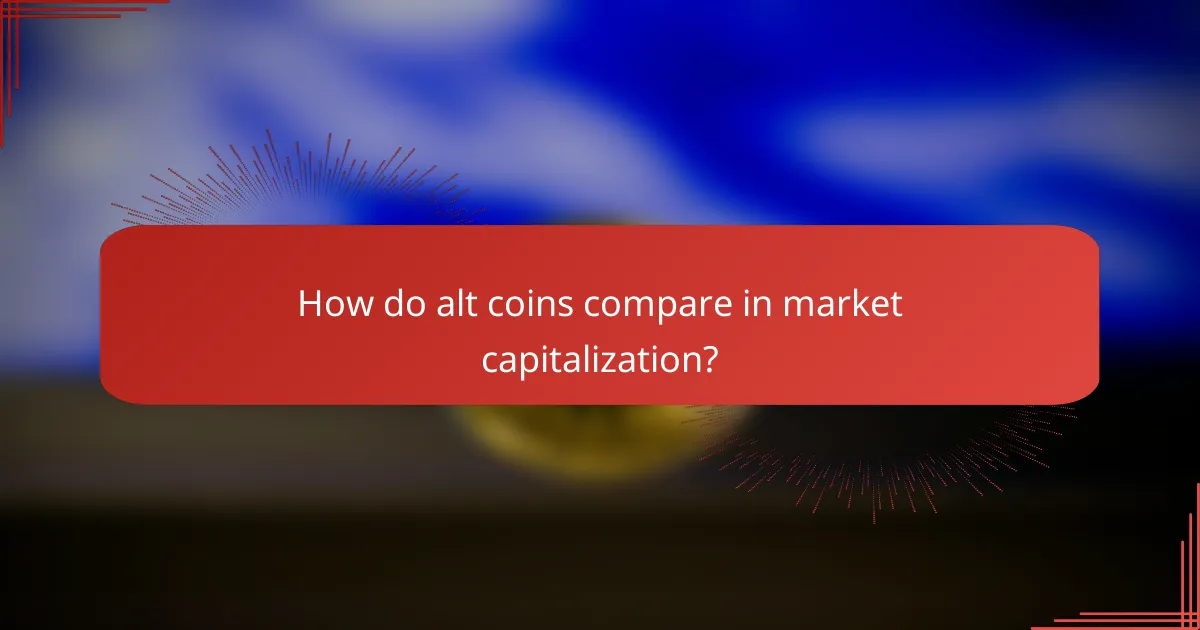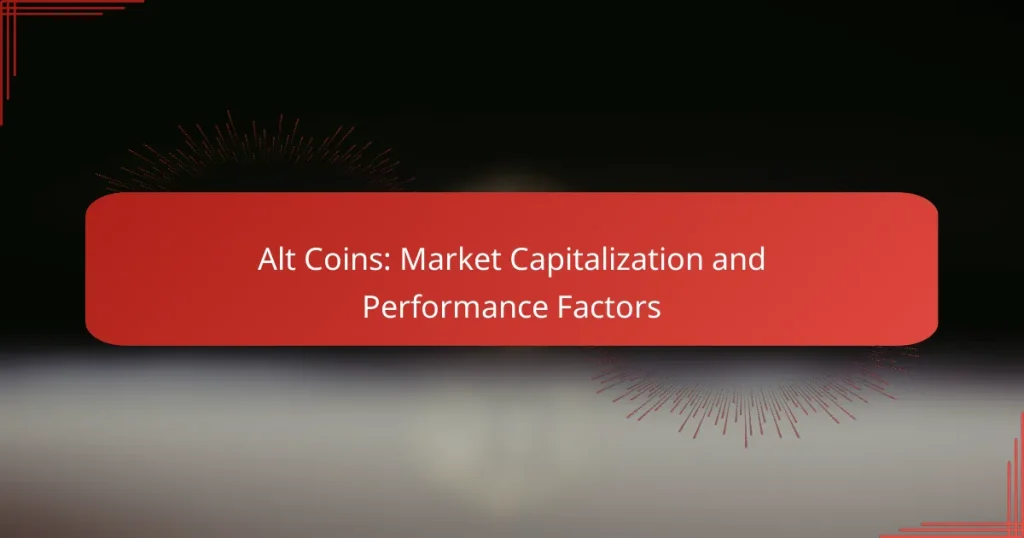Alt coins, or alternative cryptocurrencies to Bitcoin, represent a diverse range of digital assets with varying market capitalizations that indicate their total market value. While Bitcoin remains the market leader, many alt coins have established significant positions, often ranking among the top cryptocurrencies. The performance of these alt coins is shaped by factors such as market demand, technological innovations, and regulatory changes, making it essential for investors to understand these dynamics for informed investment decisions.

How do alt coins compare in market capitalization?
Alt coins, or alternative cryptocurrencies to Bitcoin, vary significantly in market capitalization, which reflects their total market value. While Bitcoin dominates the market, many alt coins have carved out substantial niches, often ranking within the top cryptocurrencies by market cap.
Top alt coins by market cap
The leading alt coins by market capitalization typically include Ethereum, Binance Coin, and Cardano. As of late 2023, Ethereum often holds the second position after Bitcoin, with a market cap in the hundreds of billions of USD, while Binance Coin and Cardano usually follow with market caps in the tens of billions.
Investors often look at these top alt coins for diversification beyond Bitcoin, as they can offer unique features and use cases, such as smart contracts and decentralized finance (DeFi) applications.
Market cap trends in 2023
In 2023, the market capitalization of alt coins has shown volatility, influenced by regulatory developments and market sentiment. Many alt coins experienced significant price fluctuations, with some gaining traction due to technological advancements or partnerships.
Overall, the market cap of alt coins has generally trended upward, reflecting growing interest in cryptocurrencies beyond Bitcoin. Investors should monitor these trends closely, as they can indicate shifting investor confidence and potential opportunities.
Comparison with Bitcoin
Bitcoin remains the largest cryptocurrency by market capitalization, often accounting for over 40% of the total crypto market. In contrast, alt coins collectively represent a growing share, with Ethereum frequently leading the pack.
While Bitcoin is often viewed as a store of value, many alt coins are designed for specific functionalities, such as enabling smart contracts or facilitating transactions on decentralized platforms. This differentiation can impact their market performance and investor interest.

What factors influence alt coin performance?
Alt coin performance is primarily influenced by market demand and supply, technological advancements, and regulatory impacts. Understanding these factors can help investors make informed decisions about their investments in alternative cryptocurrencies.
Market demand and supply
Market demand and supply play a crucial role in determining the price and performance of alt coins. When demand for a specific alt coin increases, its price typically rises, while an oversupply can lead to price declines. Factors such as investor sentiment, market trends, and news events can significantly impact demand.
For instance, if a popular influencer endorses an alt coin, demand may surge, leading to rapid price increases. Conversely, if negative news surfaces, such as security breaches or project failures, demand can plummet, causing significant losses for investors.
Technological advancements
Technological advancements can greatly enhance the performance of alt coins by improving their functionality, security, and scalability. Innovations such as faster transaction speeds, lower fees, and enhanced privacy features can attract more users and investors to a particular alt coin.
For example, alt coins that implement smart contract capabilities or interoperability with other blockchains may see increased adoption. Investors should monitor ongoing developments and updates in the technology behind alt coins to gauge their potential for growth.
Regulatory impacts
Regulatory impacts can significantly affect the performance of alt coins, as government policies and regulations can either support or hinder their growth. In regions where cryptocurrencies are embraced, alt coins may thrive, while in areas with strict regulations or outright bans, their performance may suffer.
For instance, countries like the United States and the European Union have established frameworks for cryptocurrency regulation, which can provide clarity and stability for investors. Conversely, sudden regulatory changes can lead to market volatility, making it essential for investors to stay informed about the legal landscape surrounding alt coins.

How to evaluate alt coin investments?
To evaluate alt coin investments, consider both technical and fundamental analysis along with risk assessment techniques. These methods help investors make informed decisions based on market trends, project viability, and potential risks.
Technical analysis methods
Technical analysis involves studying price charts and market trends to forecast future price movements. Key indicators include moving averages, Relative Strength Index (RSI), and Fibonacci retracement levels. Investors often look for patterns such as head and shoulders or double tops to identify potential buy or sell signals.
For effective technical analysis, focus on time frames that match your investment strategy. Short-term traders might analyze hourly charts, while long-term investors may prefer daily or weekly charts. Always consider market volume alongside price movements to confirm trends.
Fundamental analysis criteria
Fundamental analysis evaluates the underlying factors that could affect an alt coin’s value. Key criteria include the project’s use case, team expertise, community support, and technological innovation. Understanding the tokenomics, such as supply limits and distribution methods, is also crucial.
When assessing an alt coin, review its whitepaper and roadmap to gauge its long-term vision. Additionally, consider partnerships and collaborations that could enhance its credibility and market reach. A strong community presence on platforms like Discord or Reddit can indicate robust support.
Risk assessment techniques
Risk assessment techniques help investors identify and mitigate potential losses in alt coin investments. Start by determining your risk tolerance, which can guide your investment size and strategy. Diversification across different alt coins can reduce exposure to any single asset’s volatility.
Utilize stop-loss orders to limit potential losses and set profit-taking targets to secure gains. Regularly review your portfolio and stay updated on market news and regulatory changes that could impact your investments. Avoid emotional trading by sticking to your predefined strategy and risk management plan.

What are the best alt coins to invest in?
The best alt coins to invest in typically include Ethereum, Cardano, and Solana, each offering unique features and growth potential. Investors should consider factors such as market capitalization, technology, and community support when evaluating these cryptocurrencies.
Ethereum performance metrics
Ethereum is often viewed as the leading alt coin, primarily due to its robust smart contract capabilities and widespread adoption. Its market capitalization frequently ranks second only to Bitcoin, reflecting strong investor confidence.
Key performance metrics for Ethereum include transaction speed, which averages around 15 transactions per second, and gas fees that can vary significantly based on network congestion. Investors should monitor these metrics as they can impact overall transaction costs and usability.
Cardano growth potential
Cardano is recognized for its strong emphasis on research-driven development and sustainability. Its unique proof-of-stake consensus mechanism allows for energy-efficient transactions, which appeals to environmentally conscious investors.
With a market cap in the mid-range compared to other alt coins, Cardano’s growth potential is influenced by its ongoing upgrades and partnerships. Investors should keep an eye on the rollout of new features, which could enhance its functionality and user adoption.
Solana scalability advantages
Solana stands out for its high throughput and low transaction costs, making it an attractive option for developers and users alike. It can handle thousands of transactions per second, significantly outpacing many competitors.
Investors should consider Solana’s scalability advantages when evaluating its long-term viability. The platform’s ability to support decentralized applications and NFTs positions it well in the evolving crypto landscape, but potential risks include market volatility and competition from other scalable blockchains.

What are the risks associated with alt coin investments?
Investing in alt coins carries several risks that can significantly impact returns. Key risks include market volatility, security vulnerabilities, and regulatory uncertainties that can affect the overall performance of these digital assets.
Volatility and market risks
Alt coins are known for their extreme price fluctuations, often experiencing rapid increases and steep declines. This volatility can lead to significant gains or losses in a short period, making it crucial for investors to be prepared for sudden market changes.
To manage volatility, consider setting clear investment goals and limits. Use stop-loss orders to protect against major downturns and diversify your portfolio to spread risk across different assets.
Security threats and hacks
Security threats are a major concern in the alt coin market, with exchanges and wallets being frequent targets for hackers. Breaches can result in the loss of funds, which may not be recoverable, emphasizing the need for secure storage solutions.
Investors should use reputable exchanges and enable two-factor authentication (2FA) for added security. Storing alt coins in hardware wallets rather than on exchanges can also reduce the risk of theft.
Regulatory compliance issues
Regulatory compliance is an evolving challenge for alt coin investors, as different countries have varying laws regarding cryptocurrency. Changes in regulations can impact the legality and usability of certain alt coins, affecting their market value.
Stay informed about the regulatory landscape in your country and consider investing in alt coins that comply with local laws. Engaging with communities and following news sources can help you anticipate regulatory changes that may affect your investments.

What tools can help track alt coin performance?
Several tools can effectively track the performance of alt coins, providing insights into price movements, market capitalization, and trading volumes. Utilizing these resources can enhance your investment decisions and help you stay informed about market trends.
CoinMarketCap features
CoinMarketCap is one of the most popular platforms for tracking alt coin performance. It offers real-time data on price, market capitalization, trading volume, and historical performance for thousands of cryptocurrencies. Users can filter coins by various criteria, including market cap size, price changes, and trading pairs.
Additionally, CoinMarketCap provides tools like price alerts and portfolio tracking, allowing users to monitor their investments efficiently. The platform’s user-friendly interface makes it accessible for both beginners and experienced traders.
CryptoCompare analytics
CryptoCompare is another valuable resource for analyzing alt coin performance. It offers comprehensive data on price, volume, and market capitalization, along with detailed charts and historical data. Users can compare different cryptocurrencies side by side, which helps in making informed investment choices.
The platform also features a community section where users can share insights and discuss market trends. This collaborative aspect can provide additional perspectives on alt coin performance and potential investment opportunities.
TradingView charting tools
TradingView is renowned for its advanced charting capabilities, making it a favorite among traders looking to analyze alt coin performance. It offers a wide range of technical indicators and drawing tools that can help users identify trends and potential entry or exit points.
Users can customize charts to reflect their trading strategies and share their analyses with the TradingView community. This social aspect allows traders to learn from each other and refine their approaches to alt coin investments.


